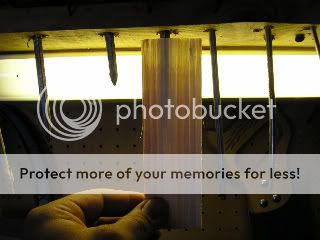
Made a couple of tip wedges over the weekend. I had never heard of tip wedges before, until reading a post about power lams and tip wedges over at the Pirates of Archery. Basically the tip wedge will add a bit of stiffness at the ends. The same goes for a power lam (which I'm not using here on this bow) which is placed at the ends of the riser and changes the dynamics of where the working portion of the limb will be i.e closer the the riser or further out in the limb. Experimenting with this, a bowyer can get the most efficiency and performance from the limbs.
I however, have to get a working bow completed before I can start experimenting with these different applications. Some of the guys I have spoken with will make several bows of a particular style before they achieve the right balance of flexibility, material and design which ends up suiting their needs for a smooth, fast and quiet bow.
I had a concern that my longer than average draw length of 30+ inches would be too much for a 62" take down. I consulted with Sixby, whom I've mentioned before and makes some fantastic looking (and shooting)take downs, and posed the question to him.
His response was that 62" is a good overall length for T/D's and that my concern with the draw length could be solved with the addition of tip wedges. These wedges, he said, should eliminate stacking to at least 30". His advice was to make them 6" long with a thickness of .040" tapering to 0" and to have at least 5 inches extending from the string grooves into the limb.
I had some left over bamboo flooring scrap and thinned that down to about .050 and then placed a small piece of scrap under that, which had a thickness of .040". I made a small sled just like the one I have for making the tapered lams and put it through the sander several times until I came close to my desired shape and thickness.
From that point I pretty much played it by ear, trying to get the tip as thin as possible and the taper as even and gradual as I could. The end result shown at the top of the page came out fairly well I think, with the tips being very thin. The measurements I took showed that thickness along the length of both wedges is fairly consistent and the thick end coming in at .040"
So that's it for now in terms of making the components that make up the bow. The next step will be to do a mock up or dry run of the glue up and then the actual glue up it self. I'm going to have to wait a couple days to get the smooth-on, but I did manage to find a distributor close to me which should help reduce cost by saving on shipping.
I'll do the mock up this week and if everything looks good, the final glue up early next week. Stay tuned!

nice post, learn a lot info about recurve bows from this article.
ReplyDelete